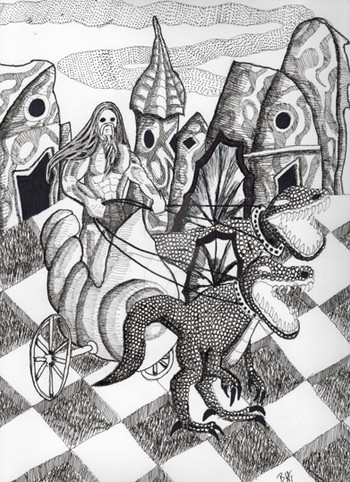HOME | DD
 leonardismos — Populating Mu - Holocene's mammals (part 2)
leonardismos — Populating Mu - Holocene's mammals (part 2)

#populatingmu #speculativeevolution #speculativebiology #spectember #speculativezoology #spectember2023
Published: 2023-10-10 12:38:04 +0000 UTC; Views: 7437; Favourites: 136; Downloads: 0
Redirect to original
Description
Bringing a few more muvian mammals, here I decided to explore the herbivores of our beloved island.
a) Southern tapir (Mutapirus australis): a tapir found in southern Mu, from the hot semiarid to the hot Mediterranean portions of the island and in the Kelarbor Archipelago. These mammals are generalist herbivores that live in small loose groups, differently from other known tapirs. Reaching 1,1m tall on shoulder and 250kg, the southern tapir have long legs and short beige fur. The calf lacks the traditional spotted pattern seen in tapirs worldwide.
- The southern tapir is one of the direct descendants of triloboii’s Mutapirus giganteus;
b) Spotted hog (Compsotapirus diminuta): a small tapir found only in the easternmost tip of Mu, in the forests and swamps from the Anleolan Palm Coast to Elvakerm River Valley. Solitary and timid, the spotted hogs got their name due to the small and short legged build that resembles a small pig and the keeping of the spotted calf pattern when adults. Reaching 60cm long and 15kg, these tapirs are browsers that prefer to forage during the night and stay hidden in the day.
- The spotted hog is one of the direct descendants of Another_leo(Leonardismos)’s short trunked tapir;
c) Northern tapir (Compsotapirus barocephalus): a large and heavy tapir found all across Mu, with exception of the warmer biomes of the south of the island. This animal reaches 2,5m long and 400kg, with the northern populations tending to be bigger than the southern ones. These browsers are solitary and a calm creature, females give birth to a single calf and take care of it during the first 2 or 3 years.
- The northern tapir is one of the direct descendants of Another_leo(Leonardismos)’s short trunked tapir;
d) Four horned mulope (Dynamocapra tetraceros): gracile cornucamelids found in the Mediterranean and both hot and cold semiarid portions of Mu. These creatures are fast runners and social browsers that live in small groups with a dominant male, while other males are solitary. Reaching 70cm tall on shoulder and 60kg, the four horned mulope is a common sight in plains as scrublands.
- The four horned mulope is one of the direct descendants of dynamoterror1011’s Quadrumeryx variabilis;
e) Giant ankoo (Ankoo altus): social herbivores, this cornucamelid is one of the tallest found in Mu, reaching 1,5m on shoulder and 450kg. Giant ankoos can be seen all across northern Mu, with preference for open environments and woodlands. The ossicones are present in both sexes and used as social display, while the main forms of defense are running or kicking. Females give birth to one calf and the herd helps to protect them from predators.
- The giant ankoo is one of the direct descendants of dynamoterror1011’s Ankoo fuscus;
f) Striped ankoo (Ankoo harmonii): one of the most common ankoos of Mu, the striped ankoo is found all across Mu, with exception of the colder northern biomes and alpine regions. These cornucamelids got their name from the dull patterning seen in adults, which is more evident in juveniles. Reaching an average of 100cm tall on shoulder and 80kg, these herbivores are social creatures and sometimes congregate in herds with more than 30 individuals.
- The striped ankoo is one of the direct descendants of dynamoterror1011’s Ankoo fuscus;
g) Porcupine deer (Togemumeryx terrori): here presented in defensive posture, the porcupine deer is an herbivore and solitary creature found in the forests and swamps along the Megalake Spifirnda. Timid and easily startled, the porcupine deer have two main ways to deal with threats: running as fast as it can or erecting the hard bristle like fur on its back to appear to be a bigger challenge than it really is. These moschid deers are known to use burrows abandoned by other creatures and their peak of activity is during the crepuscular hours. Their average height is 30cm tall and can reach 10kg.
- The porcupine deer is one of the direct descendants of dynamoterror1011’s Micromumeryx fabaphilus;
SailWorldbuilds


























